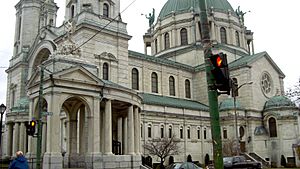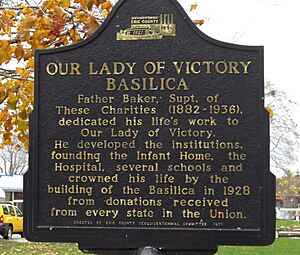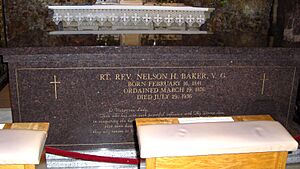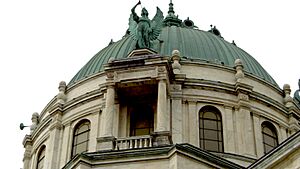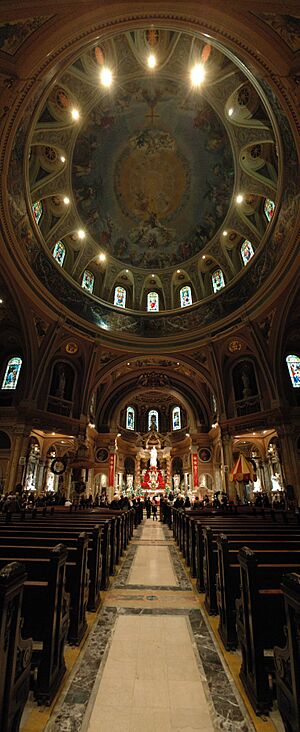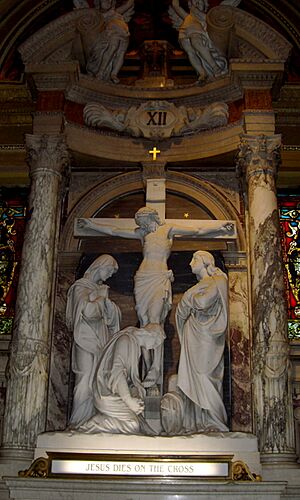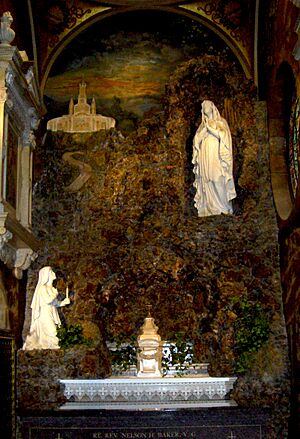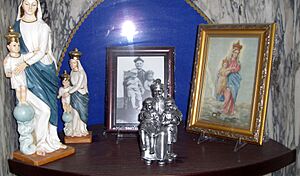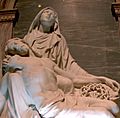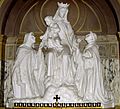Our Lady of Victory Basilica (Lackawanna, New York) facts for kids
Quick facts for kids Our Lady of Victory Basilica |
|
|---|---|
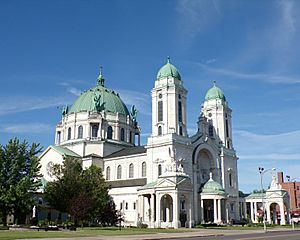
The front exterior of Our Lady of Victory Basilica.
|
|
| Religion | |
| Affiliation | Roman Catholic |
| District | Diocese of Buffalo |
| Ecclesiastical or organizational status | Minor Basilica, National Shrine |
| Leadership | Bishop: Michael W. Fisher Pastor: Reverend Monsignor David G. LiPuma |
| Year consecrated | 1926 |
| Location | |
| Location | 767 Ridge Road Lackawanna, New York, United States |
| Architecture | |
| Architect(s) | Emile Ulrich |
| Architectural type | Basilica |
| Groundbreaking | 1921 |
| Completed | 1926 |
| Specifications | |
| Direction of façade | North |
| Capacity | 1,200 sitting |
| Dome height (outer) | 165 feet (50 m) |
| Dome height (inner) | 120 feet (37 m) |
| Dome dia. (inner) | 80 feet (24 m) |
| Spire(s) | 2 |
| Materials | Marble |
| Website | |
| www.ourladyofvictory.org | |
The Our Lady of Victory Basilica is a special Catholic church and national shrine located in Lackawanna, New York. It's a popular place for visitors and pilgrimages because of the many good things done by its founder, Father Nelson Baker. This church is part of the Diocese of Buffalo.
Contents
History of the Basilica
In 1916, a fire badly damaged St. Patrick's Parish Church in Lackawanna. Even though repairs were made, Father Baker, who was the main priest, wanted to build a new, bigger church. On May 7, 1921, Father Baker held the last Mass at St. Patrick's.
The old church was taken down right away to make room for the new one. Construction on the basilica started in 1921. Father Baker wanted to build a beautiful shrine to honor the Blessed Mother. Because Father Baker was well-known for his charity work across the country, he was able to get enough money quickly. Thousands of people from all over helped fund the project, mostly through a special fundraising club. The basilica was designed by Emile Ulrich and cost $3.2 million to build. Amazingly, the church didn't have any debt when it was finished.
By late 1925, the main part of Our Lady of Victory was complete. The first Mass was held there on Christmas of that year. On May 25, 1926, a special ceremony took place with Father Baker, Bishop William Turner, and Cardinal Patrick Hayes. Thousands of priests, nuns, and believers came from all over the country. Two months later, Pope Pius XI gave the shrine the special title of "Minor Basilica." Father Baker continued to lead the basilica and its many charities until he passed away on July 29, 1936.
The basilica has only had two major changes since it was built. The first happened in 1941 during a big lightning storm. The storm caused a lot of damage to the basilica's two tall towers.
Father Baker's first successor, Monsignor Joseph Maguire, led the repairs. He replaced the original marble towers with shorter, enclosed copper dome-tipped towers. These are the towers you see today. After a very cold winter in 2001–2002, the roof of the National Shrine was found to be in bad shape. Its copper had turned green from the weather, like the Statue of Liberty, and it was no longer waterproof. A new copper roof was then put on.
In 2001, the National Shrine celebrated its 75th anniversary. On May 26, a special Mass was held, followed by a dinner party. Hundreds of important people, clergy members, and friends gathered to celebrate the basilica and Father Baker's lasting impact.
The basilica complex was added to the National Register of Historic Places in 2024.
Father Baker's Resting Place
In July 1998, it was announced that Father Baker's remains would be moved from a nearby cemetery to the basilica. This move was ordered by the Congregation for the Causes of Saints in Rome. It was an important step toward possibly declaring Father Baker a saint.
On March 11, 1999, Father Baker's casket was carried by six men whom he had helped raise. It was placed in a special stone coffin called a sarcophagus inside the Grotto Shrine to Our Lady of Lourdes. This grotto is on the southern side of the basilica. About 6,000 people came to the basilica that day to honor Father Baker and his work. Moving his remains helped more people around the world learn about Father Baker and his mission. On January 14, 2011, Pope Benedict XVI declared Father Baker "venerable," which means he is recognized for his holy life.
Basilica Architecture and Design
Exterior Features
The outside design of the basilica was created by a French church architect named Emile Ulrich. Father Baker wanted the best materials and work, so Ulrich stopped all other projects at his firm. He personally checked the work of artists in the United States and Europe.
Most of the outside of the shrine is made of pure white marble from Georgia. Inside the basilica and on some parts of the outside, you can find more than 40 different types and colors of Italian marble.
The Great Dome
A very noticeable part of the basilica's outside is its large copper dome. The dome is 165 feet tall. When it was finished in 1926, it was the second largest dome in the U.S., after the U.S. Capitol building. Over the years, the copper on the dome has turned a green color, which is normal as copper ages. Four copper angel statues, each 18 feet tall and playing trumpets, are placed on the dome.
The Twin Towers
The basilica's original twin towers, finished in 1926, were 165 feet tall. They were made entirely of marble and had an open design. In 1941, a strong lightning storm badly damaged both towers. This meant they had to be redesigned and repaired. The new towers are enclosed and shorter than the originals. They are topped with copper domes, similar to the basilica's Great Dome.
Main Entrance Details
Two large rows of columns, called colonnades, extend out from the main entrance of the shrine. On top of each colonnade is a marble sculpture of children with a large angel watching over them. On the left side (if you are facing the front of the basilica), a nun leads the children. This represents the Sisters of St. Joseph, who have worked at the Our Lady of Victory Institutions since 1856. On the right side, a priest, Father Baker, leads the children. Ulrich ordered this statue of Father Baker to honor him for all his contributions to the Our Lady of Victory Institutions. Also at the entrance is a domed area called a niche. It holds a 12-foot-tall, 16,000-pound statue of Our Lady of Victory, made from the best Carrara marble.
Interior Features
The Great Dome and Ceiling Artwork
The biggest artwork inside is the decoration of the Great Dome, which is 80 feet across. It shows the Assumption of Mary, where Mary is taken into heaven, and her Coronation as Queen of Heaven. Around the edge of the dome, you can see the 12 apostles and three archangels. An angelic host carries Mary towards heaven. Higher up in the dome, Jesus in red robes waits for her. At the very top of the dome, 120 feet above the floor, a white Dove of Peace looks down from Heaven.
From the Great Dome to the choir area, the ceiling is covered by five huge murals. These paintings show Mary as Queen of Patriarchs, Queen of the Apostles, Queen of the Angels, Queen of the Prophets, and Queen of the Martyrs. The two side walls of the basilica have large paintings showing scenes from the Gospels. These include the Massacre of the Innocents, the Flight into Egypt, and the Birth of Jesus at Bethlehem.
The Main Altar
The main altar has a 9-foot-tall, 1600-pound statue of Our Lady of Victory. This statue was blessed by Pope Pius XI after it was sculpted in Italy. Father Baker placed a painting of the pope on the altar in return.
Next to the altar are four twisted marble columns made of rare red marble. They remind visitors of St. Peter's Basilica in Rome. A story says that during World War I, some soldiers from Buffalo found this unique red marble in Spain. When they saw it, they immediately thought of the basilica Father Baker was building back home. They talked to the Spanish farmer who owned the land. After hearing about Father Baker, the farmer agreed to donate the "useless rock" on his property. The marble was then sent to Lackawanna to finish the basilica's altar.
The main altar stands under a bright blue dome that shows the Holy Spirit in beautiful colors. On the ceiling above the altar, a long panel represents "Queen of All Saints." Among the saints shown are Mary Magdalene, St. Anthony, St. Elizabeth, St. Anne, and St. Theresa.
Items with Papal Significance
Near the altar, at one end of the pews, you can see the umbraculum, which is a symbolic canopy or umbrella. It is kept half open until the Pope visits the basilica, at which point it is fully opened. The tintinnabulum, a small gold bell on a pole with a golden frame, stands at the other end. It is used to lead the procession when the Pope celebrates Mass in the basilica. These two items, along with the Pope's personal coat of arms hanging above the bronze main entrance doors, show that the shrine has the special title of "Basilica" within the Catholic community.
Stations of the Cross
The shrine has 14 marble Stations of the Cross along its sides. These sculptures show the final hours of Jesus before his death. Each Station was carved from a single block of marble, not from separate pieces put together. The figures are life-size. The Italian sculptor Pepini spent 14 years creating them.
The station called "Jesus Meets His Afflicted Mother" was one of Father Baker's favorite spots in the basilica. When he was in his 80s and the basilica was finished, Father Baker could often be found leaning on the pillar closest to this Station, thinking and saying prayers.
The Organ
The original organ in the choir area eventually broke down. In its place, a specially designed 54-rank pipe organ was installed. Built by the Delaware Pipe Organ Co. and put in place in 1981, the organ has three mahogany pipe towers. Each tower is shaped like an eight-foot semicircle, representing the Holy Trinity. There are 51 pipes in the three towers, with the rest of the pipes hidden behind them. The pipes are made of metal and wood, and they range in length from six inches to 18 feet.
The Grotto and Father Baker's Remains
Father Baker's remains are in a stone coffin inside the Grotto Shrine to Our Lady of Lourdes. This grotto is on the southern side of the basilica. The Grotto is carved from black lava rock that came from Mount Vesuvius in Italy. Father Baker, who passed away in 1936, wanted to find a building material that was "untouched by humans." He wanted it to honor the vision of the Blessed Mother that St. Bernadette had in Lourdes, France.
Other Interesting Places
Other Sculptures and Artwork: The inside of the basilica is filled with many religious paintings, sculptures, and mosaics. These artworks show devotion to the Blessed Mother. It's estimated that there are between 1,500 and 2,500 angels in the basilica's sculptures and artwork. Father Baker wanted to place an angel in every possible view. This was to remind visitors that even though the basilica is dedicated to Our Lady of Victory, its main purpose is to give praise and glory to God.
Pews and Aisle: The basilica's pews are made of rare African mahogany wood. They can seat more than 1,200 people. The floor and aisle of the shrine gently slope downwards. This design ensures that everyone has a clear view of the basilica's main altar.
Altars: Following the style of the architecture, five unique altars are located along the back wall behind the main altar. These altars are dedicated to: St. Patrick, St. Aloysius Gonzaga, Mary Immaculate, St. Anne, and St. Vincent de Paul. St. Vincent de Paul's work with the poor and needy greatly inspired Father Baker.
Baptistery: Next to the main altar is the baptistery. It has a marble baptismal font and many paintings on the walls and ceiling. These paintings show religious symbols and figures.
Father Baker Museum: In late 2009, work began to create a small museum about Father Baker's life and the history of the Our Lady of Victory Institutions. It is located in the basilica's basement, where a chapel and Father Baker's old rooms used to be. The museum displays many photos, official documents, old newspapers, and Father Baker's personal items. You can see things like his desk, books, clothing, and furniture. The museum also has cases with photos, information, and memorabilia from the Our Lady of Victory Institutions, such as the Infant Home, Orphanage, Protectory, and the basilica itself. On that same floor, there is a remodeled gift shop that sells religious items like rosaries and other related goods.
Images for kids
See also
 In Spanish: Basílica de Nuestra Señora de la Victoria (Lackawanna) para niños
In Spanish: Basílica de Nuestra Señora de la Victoria (Lackawanna) para niños


